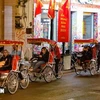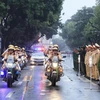Hanoi will install an automated traffic control system on Thang Long Avenue aimed at helping move traffic more smoothly as well as recording violations.
The system will be installed along sections of the 30km expressway connecting Hanoi with the starting point of the Ho Chi Minh Trail in Son Tay town, according to Hanoi Department of Transport Deputy Director Nguyen Xuan Tan.
Traffic violations will be recorded by cameras, allowing officers to contact violators later and require them to pay a fine, Tan said.
The model has been applied in a number of countries, and if successful here, will be expanded to all expressways in Hanoi.
Last November, the same system with 40 cameras was installed on a pilot basis on the Hanoi-Vinh and Ho Chi Minh City-Can Tho highways.
After one month of operation, the system identified 650 violations and resulted in the collection of over 500 million VND (24,000 USD) in fines, according to traffic police in charge of the area.
According to Dinh Van Hiep, former director of the Institute of Planning and Transportation Engineering, the system requires highly-trained technical teams to manage and operate.
“Vietnam does not currently have any personnel experience in running automated traffic control systems,” Hiep said. “Therefore, it will be necessary to create training programmes so that technical teams are ready for this work.”
Under the Ministry of Transport plan for installing automated traffic systems, the process will be extended into three phases between now and the year 2030.
Under the first phase in 2012-15, three regional control centres will be built in the northern, central and southern regions.
During the second phase in 2015-20 and the third phase in 2020-30, the ministry will continue updating the technology and perfecting the systems.-VNA
The system will be installed along sections of the 30km expressway connecting Hanoi with the starting point of the Ho Chi Minh Trail in Son Tay town, according to Hanoi Department of Transport Deputy Director Nguyen Xuan Tan.
Traffic violations will be recorded by cameras, allowing officers to contact violators later and require them to pay a fine, Tan said.
The model has been applied in a number of countries, and if successful here, will be expanded to all expressways in Hanoi.
Last November, the same system with 40 cameras was installed on a pilot basis on the Hanoi-Vinh and Ho Chi Minh City-Can Tho highways.
After one month of operation, the system identified 650 violations and resulted in the collection of over 500 million VND (24,000 USD) in fines, according to traffic police in charge of the area.
According to Dinh Van Hiep, former director of the Institute of Planning and Transportation Engineering, the system requires highly-trained technical teams to manage and operate.
“Vietnam does not currently have any personnel experience in running automated traffic control systems,” Hiep said. “Therefore, it will be necessary to create training programmes so that technical teams are ready for this work.”
Under the Ministry of Transport plan for installing automated traffic systems, the process will be extended into three phases between now and the year 2030.
Under the first phase in 2012-15, three regional control centres will be built in the northern, central and southern regions.
During the second phase in 2015-20 and the third phase in 2020-30, the ministry will continue updating the technology and perfecting the systems.-VNA



















